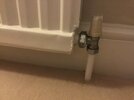Just moved into a 1980‘s built house with oil heating. I’m planning on fitting programmable TRV’s but just realised the rads have old 3/4 connections (with a captive nut at the rad end) so no go with the TRV bodies I’ve got. Clearly old rads, so looks like replacement is the best bet and given they are old imperial sizes I can pick a smaller width metric size and use extended tails to connect which should make it easier to connect and help not put undue stress on the existing pipe work (much of which is buried in the screed). The other odd thing is that all the radiators have lockshields at both ends. Was this normal back then. I’ve never seen it before.
Given that I will have a couple of rooms that will be empty most of the time this winter. I wanted programmable valves to easily shut down heating in those rooms. Presumably, in the meantime I can shut down those rooms by closing one of the lockshields to do the same thing. A bit of a pain but ok until I change the Rads. I’d appreciate any thoughts.
Given that I will have a couple of rooms that will be empty most of the time this winter. I wanted programmable valves to easily shut down heating in those rooms. Presumably, in the meantime I can shut down those rooms by closing one of the lockshields to do the same thing. A bit of a pain but ok until I change the Rads. I’d appreciate any thoughts.


